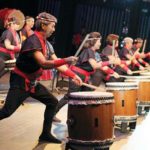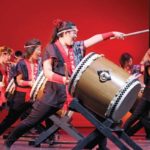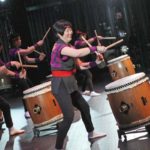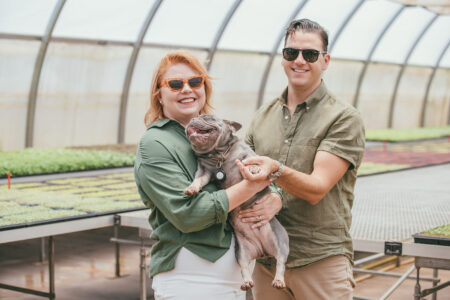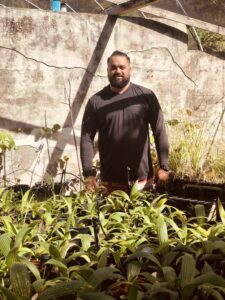Maui Taiko celebrates 20 years
KAHULUI — For decades, Kay Fukumoto’s family performed taiko at bon dances, playing the song that Japanese immigrants from the Fukushima prefecture brought to the sugar plantations in the early 1900s.
“It was very casual,” Fukumoto said. “A bunch of men would get together like two months before bon dance to practice.”
What was once a summer tradition later morphed into a nonprofit that performs nearly 60 times a year, keeping songs from the old country alive but also playing new compositions created by some of the descendants of those first plantation taiko performers.
On Sunday, Maui Taiko marked its 20th anniversary with a concert in the Maui Arts & Cultural Center’s Castle Theater. Guest performers San Jose Taiko, the all-female Uneme Taiko group from Japan, shakuhachi (bamboo flute) master Marco Lienhard from New York and local folk dance groups Nakayama Minyo Kai and Maui Minyo Kai joined in the celebration.
In the early 1900s, immigrants at the Keahua sugar plantation, below Pukalani and west of Haliimaile, got together every year to perform “Fukushima Ondo” at the obon festival, said Fukumoto, Maui Taiko’s president. After the plantation closed, the drums and the yagura, or bon dance tower, were donated to Paia Mantokuji, though the group continued to perform. When an art form called kumi daiko, or ensemble drumming, got popular on Maui, the group practiced more often and decided to create a separate nonprofit.
“For ‘Fukushima Ondo,’ we only used to play that during bon season, which was three months out of the year,” said Fukumoto, whose father, Albert Watanabe, was one of the Maui Taiko founders. “Kumi daiko allowed us to perform year-round. It had a different way of expression because we could create our own music. Taiko drumming is not just music, because it’s dance, it’s a very visual, expressive art form.”
When Maui Taiko first started in 1996, it had about 10 members. Now it’s up to 40, and the group performs almost every weekend. Because a genuine taiko from Japan can cost $3,000 to $5,000, members have crafted their own taiko from used wine barrels.
Fukumoto is a fourth-generation drummer who used to follow her father and grandfather to rehearsals. At the age of 10, she startled the older members of the group when she walked up to one of the drums and started thumping out a beat.
“They said, ‘Wow, how did she learn this?’ It was just mainly by being with them,” Fukumoto said. “I wonder if that’s how traditions begin. . . . You’re with your family all the time, watching. That kind of happened with my son, too. As soon as he was born, he was being taken to all these bon dances. And now he’s so much more involved with taiko than I am.”
Fukumoto’s husband, Ronald, is also part of Maui Taiko. They encourage parents to get involved with the group, even if they initially only planned to enroll their child.
Paul Hiranaga, his wife, Beverly, and older daughter, Kiana, joined in 2007. Daughter Kalena, just 5 at the time, was too young. But after one year, “Kay said, ‘I think Kalena knows the music.’ So she started drumming at 6,” Paul Hiranaga recalled. The Hiranagas spent almost every weekend performing together.
“I think it’s an excellent family activity,” Paul Hiranaga said. “Before, the girls danced hula, and even though we would take them to their lessons, we were sort of detached. . . . But when we all perform together, we feel like a unit.”
From shows to Japan trips to researching family histories for a documentary, the Hiranagas also have appreciated the cultural connection.
“A lot of people nowadays don’t take into consideration how they got to where they are,” said Kiana Hiranaga, who will be a junior at the University of Portland. “Our ancestors and our grandparents, they had to go through a lot of hardships for us to live a comfortable life right now, and people just take it for granted.”
While taiko, which literally means “drum,” goes back thousands of years, the actual art of kumi daiko and bringing various drums together to perform on stage didn’t arise until the late 1950s in Japan, said Wisa Uemura, the Maui-born executive director of San Jose Taiko. A decade later, the tradition came to North America, where the word “taiko” has come to represent performance drumming.
A 1993 Maui High graduate, Uemura was “mesmerized” by kumi daiko and joined a group while attending Stanford University. After she graduated in 1997, she decided to take some time off and perform professionally with San Jose Taiko, the third-oldest kumi daiko group outside of Japan.
“What was supposed to be a two-year break between undergraduate and graduate became a life story,” Uemura said. “Even though I didn’t come to San Jose Taiko to learn more about my cultural identity, it’s a very large reason of why I stayed.”
Next year is the 150th anniversary of the arrival of the first Japanese immigrants in Hawaii. Groups like Maui Taiko give a glimpse of how culture and customs have adapted over the years.
“Especially because our tradition came from the sugar plantation days, the closing of HC&S last year really affected me, realizing that change is going to happen, but that there’s ways for us to hold on to some of those traditions,” Fukumoto said. “I think what happens is, as an immigrant, you come here just thinking about work, but as you make a life here, you want to hold on to some things from Japan, from the mother country.”
* Colleen Uechi can be reached at cuechi@mauinews.com.
- Members of Maui Taiko perform a number during the group’s 20th anniversary concert in the Maui Arts & Cultural Center’s Castle Theater on Sunday. The concert also featured guest performers San Jose Taiko, Uneme Taiko, Maui Minyo Kai, Nakayama Minyo Kai and shakuhachi (bamboo flute) master Marco Lienhard. The Maui News / COLLEEN UECHI photo
- Maui Taiko played songs that included the stories of Japanese immigrants in the cane fields, which is where the group traces its roots. Families living in the Keahua sugar plantation in the early 1900s performed taiko informally at annual obon dances, eventually forming Maui Taiko in 1996. The Maui News / COLLEEN UECHI photo
- San Jose Taiko executive director and Maui native Wisa Uemura drums alongside members during one of the group’s three numbers. Founded in 1973, San Jose Taiko is the third-oldest kumi daiko group outside of Japan. The Maui News / COLLEEN UECHI photo

